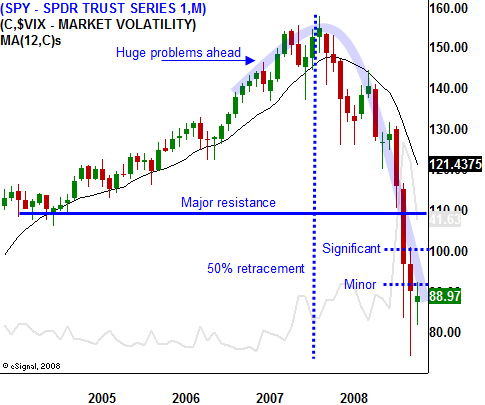Good Riddance 2008 – Hello 2009!
Not much is going to happen today or tomorrow so I want to review the events in the past year. The market was chugging along and it made a new all-time high in October of 2007. The cracks in the dam surfaced a year ago when we failed to see a year-end rally in a pre-election year.
January painted a very clear picture when the market broke a five-year uptrend line and it breached the 12-month moving average. In July, the market broke the neckline of a head-and-shoulders formation on a four-year chart when it broke below SPY 130. During August, the market tried to tread water even though bad news lurked around every corner. September, October and November brought the heaviest selling any of us have ever witnessed. This was the third worst year in the market - ever. Only 1907 and 1929 surpassed this crash. At its worst point, the market had retraced more than 50% from its October 2007 high.
If you compare this decline to the "tech bubble" of 2000, this move took six months to unfold compared to three years. This dramatic decline tells us that major problems lie ahead. During the tech bubble, stocks were overvalued and some of the "fluff" needed to be taken out. In 2008, a much greater problem presented itself. From the government, to the states, to the municipalities, to individuals, our country is laden with the mountain of debt. This problem has been compounding over decades and our financial system is on the brink of failure. Interest rate reductions had little impact and the Fed was forced to get creative. Countless times throughout the year they made unprecedented moves.
Assets of every type declined in value as a massive liquidation unfolded. There was no safe haven and stocks, real estate, bonds and commodities all declined. There was (and still is) a shortage of cash.
The Fed has come up with two solutions. First, it will bail out financial institutions, homeowners, failed auto manufactures, states running deficits and anyone else that is "too large to fail". Secondly, the Fed will print money by buying US Treasuries. In doing so, they will spark inflation. Theoretically, asset prices will rise as the dollar gets decimated. At just the right moment, they will slam on the brakes to curb inflation.
They are desperate for a solution and they've already tried everything else imaginable. The bottom line is that Americans don't want to feel any pain. Our economy has artificially been supported by decades of overspending and our debt burden has us in a choke hold. Inefficient companies have been able to survive because recessions have been stopped.
In the last eight years our national debt has increased 150%. It has run up from $4 trillion-$10 trillion and that does not include all of the proposed bailouts. As the unemployment rate continues to climb, states will be seeking aid from the Fed. Five of the biggest states have already blown through their unemployment funds. As Americans lose their jobs, income tax revenues will decrease and the budget deficit will grow. A month ago, Standard & Poor's warned that the US could lose its AAA credit rating.
One looming statistic puts everything into perspective. In 10 years, 100% of our national budget will go to paying interest on our national debt and to Social Security. This window will move forward if we lose our credit rating or increase our national debt. If we default on our bonds, our financial system will collapse. If we curb Social Security payments the majority of Americans will die in poverty. More than two thirds of all baby boomers have less than $100,000 saved. Mind you, these two items alone will eat up the entire budget and there is nothing left over for defense, education, healthcare or anything else. In reality, we are not talking about a 10-year window; it is much closer than that.
If we inflate our way out of the current problem, the freight train will still be coming at us. The solution to the debt problem is not more debt. The world does not want to support our lifestyle and I believe the appetite for US debt will decline. That will play out in 2009 as we try to secure financing for all of our bailouts. England, Japan, China, Germany... all of the major economies around the world are also trying to finance their own bailouts and stimulus packages.
In the last three months, Americans have increased their savings rate after a 20 year decline. We need to work harder for less (because we are competing with the global labor force) and save more. If we do this over many years, we can avoid a financial collapse. Weak companies that should have failed will go bankrupt.
I hope that the Fed's efforts pan out. It will give us all time to save more and prepare ourselves for tough times. From a trading standpoint, there will be many opportunities on both sides of the market. When the Fed tries to manipulate market forces, there are many unintended consequences. This creates volatility and opportunity.
Traders for generations will reference the year 2008 and we will get many chances to relive it. The year ahead will be interesting. We have a new president and many issues to resolve.
May 2009 bring health, happiness and prosperity to you and your family.


Daily Bulletin Continues...

